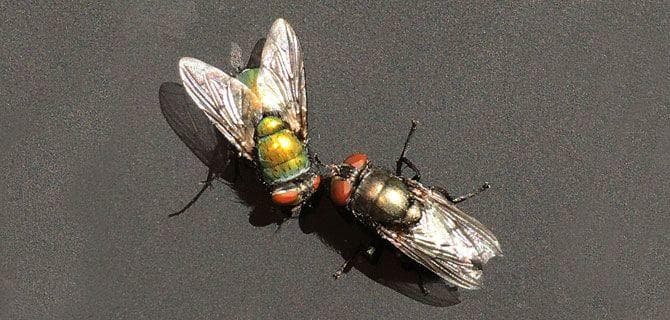Carrion insects are the stopwatches of death investigations. Within minutes of a body becoming a corpse, blow flies arrive. Forensic researchers have well-calibrated knowledge of different blow fly species’ growth rates and arrival order, so correctly identifying the species found on a corpse can help establish time of demise to within hours. However, the eggs […]

Carrion insects are the stopwatches of death investigations. Within minutes of a body becoming a corpse, blow flies arrive. Forensic researchers have well-calibrated knowledge of different blow fly species’ growth rates and arrival order, so correctly identifying the species found on a corpse can help establish time of demise to within hours. However, the eggs of different blow fly species are hard to tell apart. Forensic chemists now offer a three-minute chemical identification of blow fly eggs: an amino acid profile generated by mass spectrometry. The method could make insect profiling quicker, cheaper, and more widely used.
In a body discovered 72 hours or more after death, many forensic clues for time of death, such as body temperature, skin color, and degree of rigidity, have plateaued. That’s when insects can be most helpful. Insect clocks operate on the principle that developmental stages for insect species last for predictable amounts of time. Forensic entomologists figure out the insect species present and their current life stage—whether egg, larva, pupa, or adult—then use temperature and humidity at the site to get a time window for when colonization of the corpse occurred.
The tricky part is that eggs and larvae of similar species are very difficult to tell apart, even for experts. It is still common practice to take eggs from a corpse and grow them to adults to classify them, a process that can take three days to several weeks. DNA profiling works, too, but is often prohibitively expensive.
Organic chemist Rabi A. Musah of the University at Albany, SUNY, teamed up with forensic entomologist Jennifer Y. Rosati of John Jay College of Criminal Justice to tackle the egg problem. Musah had previously categorized plants by species using direct analysis in real time mass spectrometry (DART-MS), a method that quickly measures the masses of a very broad range of molecules in a sample, with minimal sample preparation. So she thought, why not apply the technique to insect eggs?
The collaborators first collected fresh eggs from the wild. Six pork liver traps hidden in bushes around Manhattan attracted native flies: four species in the blow fly family Calliphoridae and two other species from the Phoridae and Sarcophagidae families. The scientists trapped the flies before they could lay eggs, identified them, and gave them fresh liver on which to deposit their eggs.
The scientists analyzed the eggs laid by each fly species by DART-MS. The spectral fingerprints immediately revealed species-specific differences, primarily as variations in free amino acids levels in the eggs.
An inexpensive, fast diagnostic test such as this would be welcome, says Jeffery K. Tomberlin, who directs the Forensic Laboratory for Investigative Entomological Sciences (FLIES) facility at Texas A&M University. Since each species has a different rate of development, “species identification is very important.” A time-of-death calculation that differs by a few hours “could be the difference between an individual being accused or not of a crime.”
Musah, Rosati, and coworkers are now using their method in an active death investigation. They are also growing their database of blow fly egg profiles: Every region has its own mix of species. “Now, eggs are the most useless of the juvenile life forms in terms of ID,” and this new method could profoundly change that, Musah says. The availability of the faster technique could make it less cumbersome to create temperature and humidity charts for blow fly development in areas where they haven’t been made, she says, dramatically expanding the value of insect profiling in time-of-death calculations.